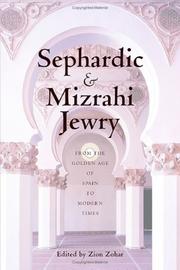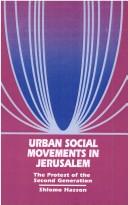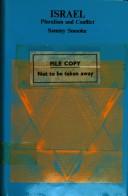| Listing 1 - 9 of 9 |
Sort by
|
Book
ISBN: 9004376712 9004376704 9789004376717 9789004376700 Year: 2018 Publisher: Leiden, Boston: Brill,
Abstract | Keywords | Export | Availability | Bookmark
 Loading...
Loading...Choose an application
- Reference Manager
- EndNote
- RefWorks (Direct export to RefWorks)
From Catalonia to the Caribbean: The Sephardic Orbit from Medieval to Modern Times is a polyphonic collection of essays in honor of Jane S. Gerber’s contributions as a leading scholar and teacher. Each chapter presents new or underappreciated source materials or questions familiar historical models to expand our understanding of Sephardic cultural, intellectual, and social history. The subjects of this volume are men and women, rich and poor, connected to various Sephardic Diasporas—Spanish, Portuguese, North African, or Middle Eastern—from medieval to modern times. They each, in their own way, challenged the expectations of their societies and helped to define the religious, ethnic, and intellectual experience of Sephardim as well as surrounding cultures throughout the world.
Sephardim --- Mizrahim --- Adot HaMizrach --- ʻAdot ha-Mizraḥ --- Afro-Asian Jews --- Arab Jews --- ʻEdot ha-Mizraḥ --- Edot HaMizrach --- Edot HaMizraḥ --- Jewish Arabs --- Jews, Arab --- Jews, Oriental --- Mizrachim --- Mizrahi Jews --- Oriental Jews --- Jews --- History.
Book
ISBN: 9780253024343 025302434X 9780253024220 0253024226 0253024277 Year: 2017 Publisher: Bloomington, Indiana ; Indianapolis, [Indiana] : Indiana University Press,
Abstract | Keywords | Export | Availability | Bookmark
 Loading...
Loading...Choose an application
- Reference Manager
- EndNote
- RefWorks (Direct export to RefWorks)
These accounts incite a necessary conversation about Jewish history, the history of anti-Jewish discourses, French history, and theories of Orientalism in order to broaden understandings about Jews of the day.
Orientalism --- Public opinion --- Jews, Algerian --- Mizrahim --- Jews --- East and West --- Algerian Jews --- Adot HaMizrach --- ʻAdot ha-Mizraḥ --- Afro-Asian Jews --- Arab Jews --- ʻEdot ha-Mizraḥ --- Edot HaMizrach --- Edot HaMizraḥ --- Jewish Arabs --- Jews, Arab --- Jews, Oriental --- Mizrachim --- Mizrahi Jews --- Oriental Jews --- Hebrews --- Israelites --- Jewish people --- Jewry --- Judaic people --- Judaists --- Ethnology --- Religious adherents --- Semites --- Judaism --- Public opinion. --- History --- France --- Ethnic relations.
Book
ISBN: 1612494250 1612494242 1557537283 9781612494258 9781612494241 Year: 2015 Publisher: Purdue University Press
Abstract | Keywords | Export | Availability | Bookmark
 Loading...
Loading...Choose an application
- Reference Manager
- EndNote
- RefWorks (Direct export to RefWorks)
Sephardi and Mizrahi Jews in America includes academics, artists, writers, and civic and religious leaders who contributed chapters focusing on the Sephardi and Mizrahi experience in America. Topics will address language, literature, art, diaspora identity, and civic and political engagement. When discussing identity in America, one contributor will review and explore the distinct philosophy and culture of classic Sephardic Judaism, and how that philosophy and culture represents a viable option for American Jews who seek a rich and meaningful medium through which to balance Jewish tradition and modernity. Another chapter will provide a historical perspective of Sephardi/Ashkenazi Diasporic tensions. Additionally, contributors will address the term “Sephardi” as a self-imposed, collective, “ethnic” designation that had to be learned and naturalized—and its parameters defined and negotiated—in the new context of the United States and in conversation with discussions about Sephardic identity across the globe. This volume also will look at the theme of literature, focusing on Egyptian and Iranian writers in the United States. Continuing with the Iranian Jewish community, contributors will discuss the historical and social genesis of Iranian-American Jewish participation and leadership in American civic, political, and Jewish affairs. Another chapter reviews how art is used to express Iranian Diaspora identity and nostalgia. The significance of language among Sephardi and Mizrahi communities is discussed. One chapter looks at the Ladino-speaking Sephardic Jewish population of Seattle, while another confronts the experience of Judeo-Spanish speakers in the United States and how they negotiate identity via the use of language. In addition, scholars will explore how Judeo-Spanish speakers engage in dialogue with one another from a century ago, and furthermore, how they use and modify their language when they find themselves in Spanish-speaking areas today.
Sephardim --- Jews, Oriental --- Social conditions --- Identity --- Adot HaMizrach --- ʻAdot ha-Mizraḥ --- Afro-Asian Jews --- Arab Jews --- ʻEdot ha-Mizraḥ --- Edot HaMizrach --- Edot HaMizraḥ --- Jewish Arabs --- Jews, Arab --- Mizrachim --- Mizrahi Jews --- Oriental Jews --- Jews --- Jews, Sephardic --- Ladinos (Spanish Jews) --- Sefardic Jews --- Sephardi Jews --- Sephardic Jews --- Jews, Portuguese --- Jews, Spanish --- Mizrahim --- Social groups: religious groups & communities

ISBN: 0814763863 0814797415 0814797059 0814797067 Year: 2005 Publisher: New York NYU Press
Abstract | Keywords | Export | Availability | Bookmark
 Loading...
Loading...Choose an application
- Reference Manager
- EndNote
- RefWorks (Direct export to RefWorks)
Sephardic Jews trace their origins to Spain and Portugal. They enjoyed a renaissance in these lands until their expulsion from Spain in 1492, when they settled in the countries along the Mediterranean, throughout the Ottoman Empire, in the Balkans, and in the lands of North Africa, Italy, Egypt, Palestine, and Syria, mixing with the Mizrahi, or Oriental, Jews already in these locations. Sephardic Jews have contributed some of the most important Jewish philosophers, poets, biblical commentators, Talmudic and Halachic scholars, and scientists, and have had a significant impact on the development
Jews, Oriental. --- Sephardim. --- Jews --- History. --- Jews, Sephardic --- Ladinos (Spanish Jews) --- Sefardic Jews --- Sephardi Jews --- Sephardic Jews --- Jews, Portuguese --- Jews, Spanish --- Adot HaMizrach --- ʻAdot ha-Mizraḥ --- Afro-Asian Jews --- Arab Jews --- ʻEdot ha-Mizraḥ --- Edot HaMizrach --- Edot HaMizraḥ --- Jewish Arabs --- Jews, Arab --- Jews, Oriental --- Mizrachim --- Mizrahi Jews --- Oriental Jews --- Mizrahim.

ISBN: 0585078696 9780585078694 0791414272 9780791414279 0791414280 9780791414286 9781438406060 1438406061 9781438406060 Year: 1993 Publisher: Albany, NY : State University of New York Press in cooperation with the Jerusalem Institute for Israel Studies,
Abstract | Keywords | Export | Availability | Bookmark
 Loading...
Loading...Choose an application
- Reference Manager
- EndNote
- RefWorks (Direct export to RefWorks)
Social movements --- Civil rights movements --- Radicalism --- Mizrahim --- Children of immigrants --- First generation children --- Immigrants' children --- Second generation children --- Immigrants --- Adot HaMizrach --- ʻAdot ha-Mizraḥ --- Afro-Asian Jews --- Arab Jews --- ʻEdot ha-Mizraḥ --- Edot HaMizrach --- Edot HaMizraḥ --- Jewish Arabs --- Jews, Arab --- Jews, Oriental --- Mizrachim --- Mizrahi Jews --- Oriental Jews --- Jews --- Extremism, Political --- Ideological extremism --- Political extremism --- Political science --- Civil liberation movements --- Liberation movements (Civil rights) --- Protest movements (Civil rights) --- Human rights movements --- Movements, Social --- Social history --- Social psychology --- Politics and government. --- Political activity --- Jerusalem
Book
ISBN: 113520232X 1282377531 9786612377532 0203870352 9780203870358 9780415778640 0415778646 9781135202279 9781135202316 9781135202323 9780415845335 1135202311 Year: 2010 Publisher: London ; New York : Routledge,
Abstract | Keywords | Export | Availability | Bookmark
 Loading...
Loading...Choose an application
- Reference Manager
- EndNote
- RefWorks (Direct export to RefWorks)
This is the first book in English to examine the Mizrahi Jews (Jews from the Muslim world) in Israel, focussing in particular on social and political movements such as the Black Panthers and SHAS. The book analyses the ongoing cultural encounter between Zionism and Israel on one side and Mizrahi Jews on the other. It charts the relations and political struggle between Ashkenazi-Zionists and the Mizrahim in Israel from post-war relocation through to the present day.The author examines the Mizrahi political struggle and resistance from early immigration in the 1950s to formative
Mizrahim --- Protest movements --- Social movements --- Intergroup relations --- Conflict, Intergroup --- Intergroup conflict --- Relations, Intergroup --- Social interaction --- Movements, Social --- Social history --- Social psychology --- Adot HaMizrach --- ʻAdot ha-Mizraḥ --- Afro-Asian Jews --- Arab Jews --- ʻEdot ha-Mizraḥ --- Edot HaMizrach --- Edot HaMizraḥ --- Jewish Arabs --- Jews, Arab --- Jews, Oriental --- Mizrachim --- Mizrahi Jews --- Oriental Jews --- Jews --- Social conditions --- Political activity --- Panterim ha-sheḥorim (Israel) --- Black Panthers (Israel) --- Panterim shchorim (Israel) --- Israel --- Ethnic relations.

ISBN: 0710085117 Year: 1978 Publisher: London ; Henley : Routledge and Kegan Paul,
Abstract | Keywords | Export | Availability | Bookmark
 Loading...
Loading...Choose an application
- Reference Manager
- EndNote
- RefWorks (Direct export to RefWorks)
321.7 --- Jewish-Arab relations --- Mizrahim --- Judaism --- -Pluralism (Social sciences) --- -#SBIB:324H40 --- #SBIB:328H50 --- Cultural diversity --- Diversity, Cultural --- Diversity, Religious --- Ethnic diversity --- Pluralism (Social sciences) --- Pluralism, Cultural --- Religious diversity --- Culture --- Cultural fusion --- Ethnicity --- Multiculturalism --- Jews --- Religions --- Semites --- Afro-Asian Jews --- ʻEdot ha-Mizraḥ --- Edot HaMizrach --- Edot HaMizraḥ --- Jews, Oriental --- Mizrahi Jews --- Oriental Jews --- Arab-Jewish relations --- Palestine problem (To 1948) --- Palestinian Arabs --- Democratie. Plurale samenleving. Pluralisme. Democratische pluraliteit--(moderne democratie politieke stelsels) --- Politieke structuren: algemeen --- Instellingen en beleid: Azië: comparatief / diverse landen --- Religion --- Israel --- Social conditions. --- Cultural pluralism --- Jewish-Arab relations. --- 321.7 Democratie. Plurale samenleving. Pluralisme. Democratische pluraliteit--(moderne democratie politieke stelsels) --- #SBIB:324H40 --- Adot HaMizrach --- ʻAdot ha-Mizraḥ --- Mizrachim --- Arab Jews --- Jewish Arabs --- Jews, Arab
Book
ISBN: 081565345X 9780815653455 9780815634119 0815634110 Year: 2015 Publisher: Syracuse, New York : Syracuse University Press,
Abstract | Keywords | Export | Availability | Bookmark
 Loading...
Loading...Choose an application
- Reference Manager
- EndNote
- RefWorks (Direct export to RefWorks)
During the postwar period of 1948-56, over 400, 000 Jews from the Middle East and Asia immigrated to the newly established state of Israel. By the end of the 1950s, Mizrahim, also known as Oriental Jewry, represented the ethnic majority of the Israeli Jewish population. Despite their large numbers, Mizrahim were considered outsiders because of their non-European origins. Viewed as foreigners who came from culturally backward and distant lands, they suffered decades of socioeconomic, political, and educational injustices.In this pioneering work, Roby traces the Mizrahi population's struggle for equality and civil rights in Israel. Although the daily "bread and work" demonstrations are considered the first political expression of the Mizrahim, Roby demonstrates the myriad ways in which they agitated for change. Drawing upon a wealth of archival sources, many only recently declassified, Roby details the activities of the highly ideological and politicized young Israel. Police reports, court transcripts, and protester accounts document a diverse range of resistance tactics, including sit-ins, tent protests, and hunger strikes. Roby shows how the Mizrahi intellectuals and activists in the 1960s began to take note of the American civil rights movement, gaining inspiration from its development and drawing parallels between their experience and that of other marginalized ethnic groups. The Mizrahi Era of Rebellion shines a light on a largely forgotten part of Israeli social history, one that profoundly shaped the way Jews from African and Asian countries engaged with the newly founded state of Israel.
Intergroup relations --- Social movements --- Protest movements --- Mizrahim --- Adot HaMizrach --- ʻAdot ha-Mizraḥ --- Afro-Asian Jews --- Arab Jews --- ʻEdot ha-Mizraḥ --- Edot HaMizrach --- Edot HaMizraḥ --- Jewish Arabs --- Jews, Arab --- Jews, Oriental --- Mizrachim --- Mizrahi Jews --- Oriental Jews --- Jews --- Movements, Social --- Social history --- Social psychology --- Conflict, Intergroup --- Intergroup conflict --- Relations, Intergroup --- Social interaction --- History --- Political activity --- Social conditions --- Cultural assimilation --- Israel --- Dawlat Isrāʼīl --- Država Izrael --- Dzi︠a︡rz︠h︡ava Izrailʹ --- Gosudarstvo Izrailʹ --- I-se-lieh --- Israele --- Isrāʼīl --- Isŭrael --- Isuraeru --- Izrael --- Izrailʹ --- Medinat Israel --- Medinat Yiśraʼel --- Stát Izrael --- State of Israel --- Yiselie --- Yiśraʼel --- Ισραήλ --- Израиль --- Государство Израиль --- Дзяржава Ізраіль --- Ізраіль --- מדינת ישראל --- ישראל --- إسرائيل --- دولة إسرائيل --- イスラエル --- 以色列 --- Palestine --- Ethnic relations --- Mizrhaim
Book
ISBN: 1496207505 9781496207500 9781496205544 1496205545 9781496205544 9781496207487 9781496207494 1496207483 Year: 2018 Publisher: Lincoln : University of Nebraska Press,
Abstract | Keywords | Export | Availability | Bookmark
 Loading...
Loading...Choose an application
- Reference Manager
- EndNote
- RefWorks (Direct export to RefWorks)
Weaving together memoir, auto-ethnography, political analysis, and cultural critique, Lavie equates bureaucratic entanglements with pain--and, arguably, torture--to examine the conundrum of loving and staying loyal to a state that repeatedly inflicts pain on its non-European Jewish women citizens.
Social movements --- Feminists --- Mizrahim --- Single mothers --- Mothers --- Single parents --- Single women --- Adot HaMizrach --- ʻAdot ha-Mizraḥ --- Afro-Asian Jews --- Arab Jews --- ʻEdot ha-Mizraḥ --- Edot HaMizrach --- Edot HaMizraḥ --- Jewish Arabs --- Jews, Arab --- Jews, Oriental --- Mizrachim --- Mizrahi Jews --- Oriental Jews --- Jews --- Feminism --- Social reformers --- Movements, Social --- Social history --- Social psychology --- Political activity --- Economic conditions --- Social conditions --- Israel --- Dawlat Isrāʼīl --- Država Izrael --- Dzi︠a︡rz︠h︡ava Izrailʹ --- Gosudarstvo Izrailʹ --- I-se-lieh --- Israele --- Isrāʼīl --- Isŭrael --- Isuraeru --- Izrael --- Izrailʹ --- Medinat Israel --- Medinat Yiśraʼel --- Stát Izrael --- State of Israel --- Yiselie --- Yiśraʼel --- Ισραήλ --- Израиль --- Государство Израиль --- Дзяржава Ізраіль --- Ізраіль --- מדינת ישראל --- ישראל --- إسرائيل --- دولة إسرائيل --- イスラエル --- 以色列 --- Palestine
| Listing 1 - 9 of 9 |
Sort by
|

 Search
Search Feedback
Feedback About UniCat
About UniCat  Help
Help News
News